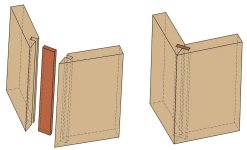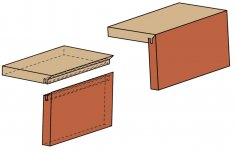Hi all,
I’m designing a wall mounted chest and looking to make it out of 1/4 sawn material. I’d like to use miter joints so I can have flowing grain all around the cabinet/chest case.
My question is, how strong would the 10mm dominos be? I reckon the cabinet would be roughly 20” wide, 35” high and 12” deep. It will be full of drawers for jewelry and bits and pieces. I haven’t finished designing it.
The cabinet will have a rebate cut for a 1/2” or so thick back. I’ll then use a cleat which will sit flush between the cabinet back and the wall. So I’d say there’d be a fair bit of force on the top of the case.
The only thing I can think of to strengthen the joint is to use splines. I’m really not keen on this as I’m designing the cabinet to be slick and flowing. So what do you reckon? Will dominos be strong enough?
I appreciate your help. Thanks!
I’m designing a wall mounted chest and looking to make it out of 1/4 sawn material. I’d like to use miter joints so I can have flowing grain all around the cabinet/chest case.
My question is, how strong would the 10mm dominos be? I reckon the cabinet would be roughly 20” wide, 35” high and 12” deep. It will be full of drawers for jewelry and bits and pieces. I haven’t finished designing it.
The cabinet will have a rebate cut for a 1/2” or so thick back. I’ll then use a cleat which will sit flush between the cabinet back and the wall. So I’d say there’d be a fair bit of force on the top of the case.
The only thing I can think of to strengthen the joint is to use splines. I’m really not keen on this as I’m designing the cabinet to be slick and flowing. So what do you reckon? Will dominos be strong enough?
I appreciate your help. Thanks!


